Are you a fitness nut always looking for the next healthy recipe or workout routine? Believe it or not, you can turn your knowledge and passion for fitness into a very profitable online business.
Yes, we’re talking about starting your own fitness blog. You can share your expertise, join a community of like-minded individuals, and even earn money with the right approach.
In this article, we will guide you through four steps to bring your fitness blog to life, along with a series of tips that have helped countless fitness blog beginners reach success.
Ready, set, go!
What is a fitness blog?
A fitness blog is a digital platform that focuses on areas such as physical fitness, exercise, nutrition, health, and well-being. Fitness blogs are usually created by individuals who are passionate about fitness, many of whom have professional qualifications in related areas.
Whether they are formally trained or not, these fitness bloggers offer information based on personal knowledge, experiences, and professional insights, aiming to inspire, guide, and motivate readers on their path to a healthier, more active lifestyle.
Topics may include:
- Nutrition and diet: Presenting balanced meal recipes and dietary advice designed to help readers in achieving their fitness goals.
- Workout routines: Offering comprehensive guides and instructions for specific workouts like weight training, yoga, or cardio regimes.
- Training programs: Crafting holistic, structured schedules to guide readers in their journey toward their fitness aspirations.
- Fitness challenges: Detailing strategic advice, tips, and insights for specific fitness events such as marathons or high-intensity interval training.
- Health and wellness: Delivering expert advice on complementary elements of fitness, including optimal sleep, efficient stress management, and recovery strategies.
- Product reviews: Conducting detailed reviews of fitness equipment, workout gear, and nutritional supplements to facilitate informed decision-making among readers.
- Personal journeys: Chronologically narrating the blogger’s fitness journey, lending an authentic touch and helping establish a connection with the reader.
- Motivation: Showcasing inspiring fitness success stories and motivational content to fuel readers’ determination on their fitness journey.
What are some examples of popular fitness blogs?
Here are some of our favorite fitness blogs:
- Nerd Fitness: This unique blog combines creativity, wit, and blogger Steve Kamb’s commitment to helping “desk jockeys, nerds, and average Joes level up their lives”.
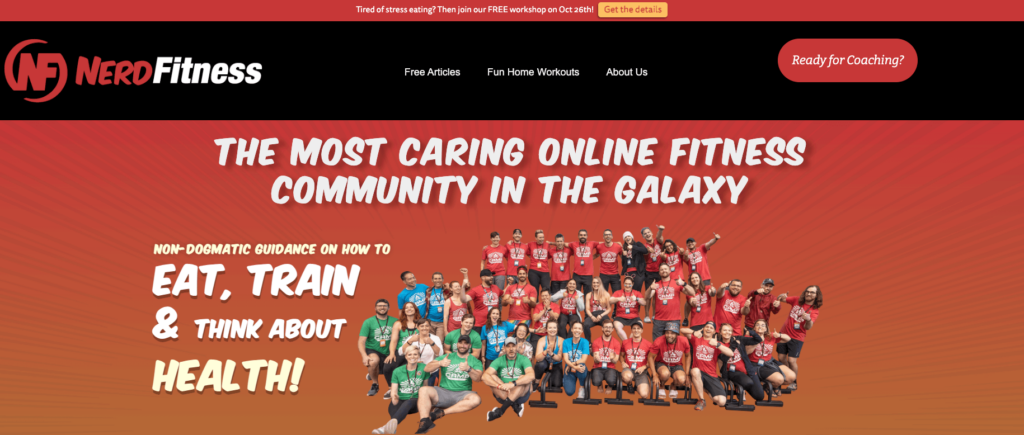
- Breaking Muscle: A great resource offering fitness and nutrition advice, training program reviews, and even personalized coaching services.
- Well & Good: Well & Good sets itself apart by offering readers protein nuggets of wisdom on achieving a balanced lifestyle.

- Mindbodygreen: This blog shifts the focus from physical fitness to mental, spiritual, and environmental wellness.
- Keep it SimpElle: A personal blog by UK-based fitness professional Elle Linton, combining fitness advice and reviews with compelling motivational posts for those embarking on their fitness journeys.

- Jessi Kneeland: Jessi Kneeland’s blog breaks traditional fitness blog barriers by focusing on body image and self-acceptance issues.
- Ben Greenfield Life: Run by triathlete and fitness guru Ben Greenfield, this blog stands out with its science-backed fitness advice.
These blogs didn’t reach their popular status overnight. Their success came from delivering quality content, engaging with their audience, and strategic marketing.
How to start a fitness blog in 4 simple steps
Starting a fitness blog from scratch might seem a bit overwhelming at first, but once you understand the mechanisms and what to avoid, it becomes a lot less intimidating.
Take the first step towards your blogging journey with our step-by-step guide.
Step 1: Choose your niche and develop your brand
Starting with a fitness blog begins with carving out your distinctive niche and developing a brand persona that makes you stand out in the bustling world of fitness experts.
Let’s break down how to achieve this.
Identify your passion
Your journey begins with taking a step back and figuring out which part of the fitness and health niche interests you the most. You may find you’re excited about more than just one area and mix nutrition, running, and mindfulness, for example. The trick is to pick topics that promise to keep you passionate about blogging, even after whipping up hundreds of posts over several years!
Capitalize on your skills
Think about the fitness areas where you’ve gathered the most experience, even if they don’t perfectly correlate with your passions. If you’re creative enough, you can use your skills to create interesting combinations. For example, if you’re a certified yoga instructor with a fondness for rock climbing, you might compile a post titled The Best Yoga Poses for Rock Climbing Recovery.
Define your blog niche
Once you’ve outlined your passions and skills, you should have a better idea of what your niche should be. While keeping a niche narrow is a smart move, it’s helpful to be flexible – you may choose to shift your blog’s focus from running to cycling as your fitness journey progresses.
Research your competitors
You need to be aware of what the current market looks like. It can be disheartening to narrow down your fitness niche and find out later that the market is already overcrowded with similar content. This research will help you come up with a fresh and unique point of view that will make you stand out from everyone else.
Define your target audience
Reflect on the type of individuals your unique blend of passion and expertise is likely to fascinate – whether it’s novice yoga students, CrossFit Games contenders, runners above the age of 50, gym enthusiasts who’ve recently turned vegan, and so forth. Note that it’s perfectly fine to cater to multiple demographic groups within your audience.
Conduct market research
It’s now time to get to know your potential audience! Administer surveys, connect with individuals in your network, or even form online groups to spark interest in your new venture and gather more ideas for content.
Choose and register a domain name
More often than not, people find this to be the hardest step and the one that requires a lot of brainstorming. Domain names need to be short, memorable, easy to spell, and ready to stand the test of time. This means that you should choose a name that will still apply even if you decide to change your niche, for example, from yoga to a healthy recipe blog. Once you’re ready, register that quickly in one of the many hosting companies like GoDaddy or Bluehost.
Step 2: Create your blog
Start by selecting a reliable blogging platform or content management system (CMS) and a web hosting provider (this can be different from the domain registration site). Many people go for a site builder like Wix or Squarespace, but they often prove insufficient when people try to grow their fitness business.
WordPress, with its extensive toolkit for blog setup, customizations, a variety of templates, and a hosting provider such as Bluehost, provides a great platform for your creative expressions.
Creating core pages is like building a strong skeleton for your blog, providing the sturdy structure it needs to stand tall in the fitness community. Here is what you need:
- Homepage.
- Blog page.
- Contact.
- Terms and conditions.
- Privacy policy.
- About me.
Designing your blog calls for a strategic plan that focuses on simplicity, caters to mobile users (since most of your audience will access your blog on handheld devices), and embodies your desired brand image.
When it comes to choosing a theme for your blog, WordPress offers many choices, including some like Fitness Blog by Smarter Themes, designed specifically for fitness websites.
Design with plugins
Customization can give your blog a unique edge in the competitive blogging world. The right plugin can not only advance your blog’s appearance but also streamline the content creation process.
WP Recipe Maker, for instance, is perfect for fitness blogs that place high importance on nutrition and health. Its easy-to-read nutritional labels and efficient nutrition facts calculation feature make it ideal for food bloggers intending to present healthy or diet-specific recipes.
Here, we’ve shared some examples where WP Recipe Maker has been effectively used to generate engaging fitness-based content:
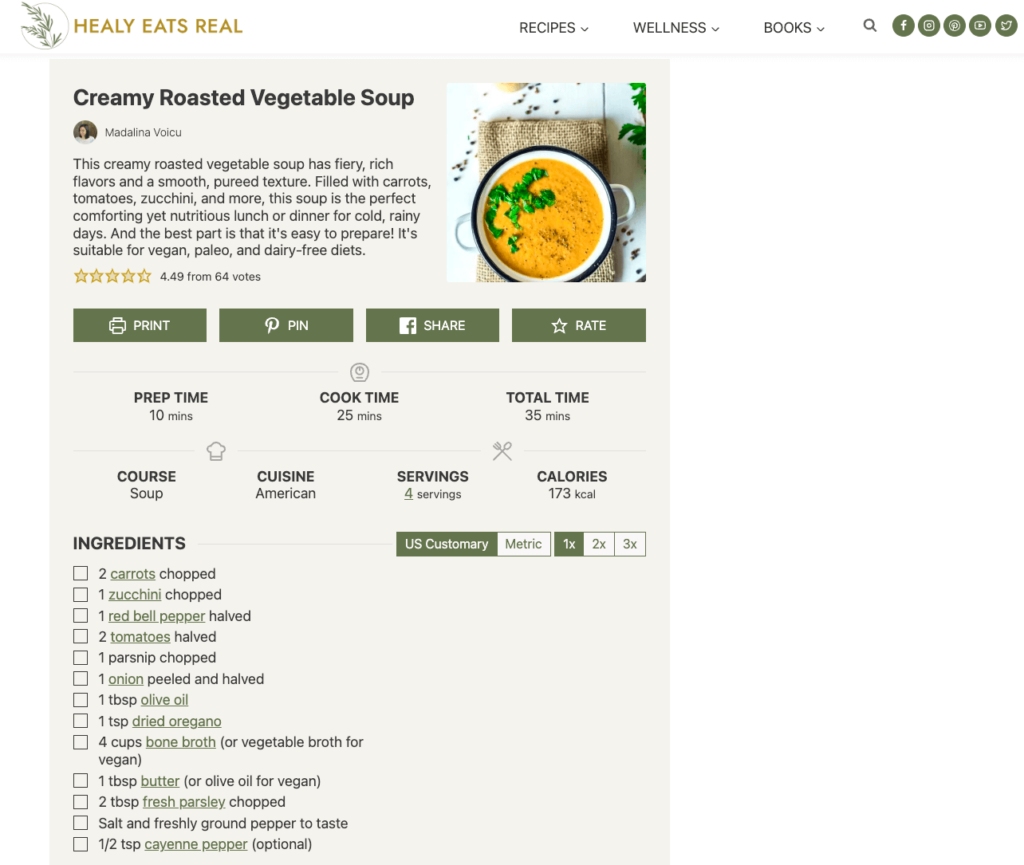
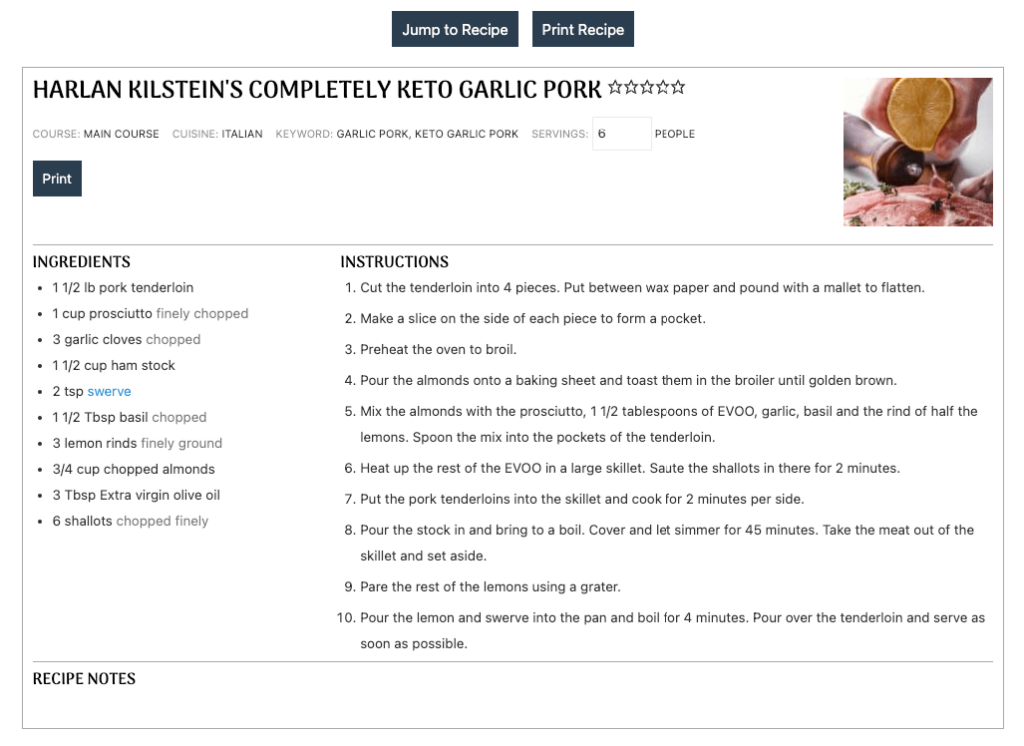
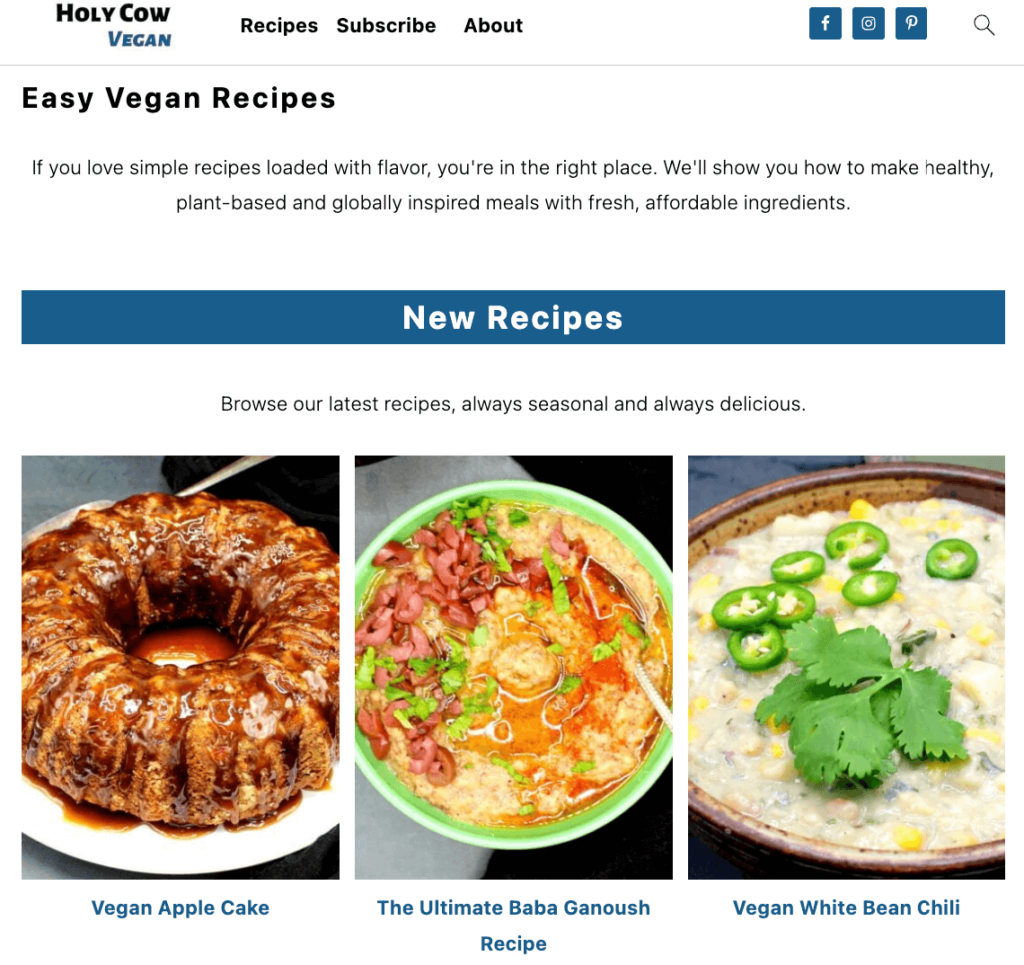
Create beautiful, user-friendly recipes with WP Recipe Maker
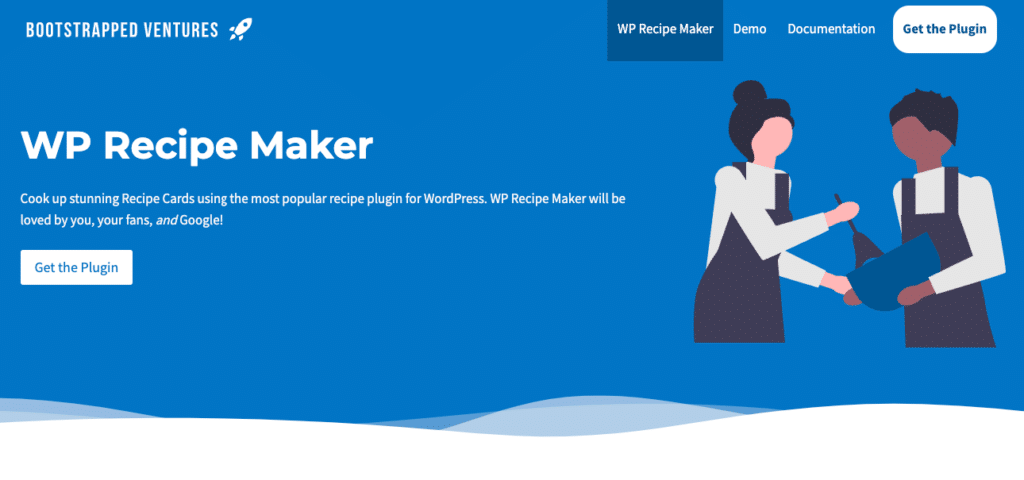
WP Recipe Maker is a fantastic tool for fitness bloggers. It improves visual appeal and presents complex nutritional information in a user-friendly way. By leveraging these resources as you shape your blog, you’re not just creating content; you’re carving out a distinctive space for yourself in the vibrant fitness blogging community.
This plugin is uniquely designed to offer explicit functionalities, such as providing detailed nutritional information to your readers.

That’s not all. The plugin’s Nutrition API integration dramatically saves time on creating these labels by guiding you through the steps to generate them.
Beyond these functionalities, WP Recipe Maker allows you the freedom to define your own custom nutrition ingredients and even formulate personalized nutrients for the label. This feature further enhances your blog’s individuality while also improving user experience.
For bloggers exploring avenues of affiliate marketing, WP Recipe Maker offers a wonderful opportunity with its equipment and ingredient links.
WP Recipe Maker – Ingredient links in recipes

Now, if you recommend certain products to your readers – say, a protein powder for their smoothie recipes – you can use these ingredient links and earn money when readers purchase through them.
Let’s look at how to incorporate this influential tool into your blog, step by step:
- Navigate to Plugins > Add New from your WordPress dashboard. Keep in mind that to install WP Recipe Maker’s paid version, you’ll need to first install the free version, which acts as the foundation for any Premium editions.
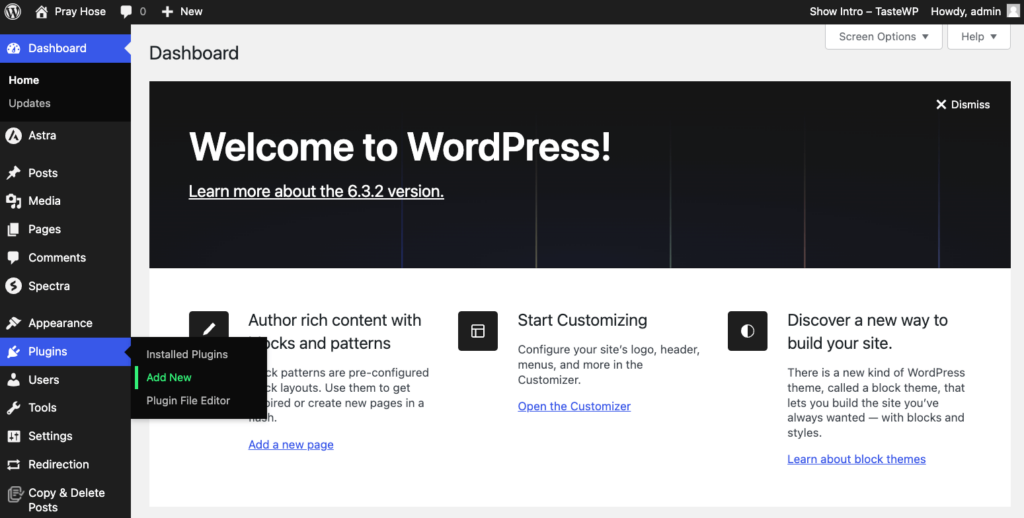
- Enter WP Recipe Maker in the search bar and click Install Now.

- Post-installation, click on Activate.

- Proceed to purchase your desired WP Recipe Maker bundle from the Bootstrapped Ventures website.
- Once purchased, you’ll receive an email with the plugin file’s download link. You can also download it directly from your account page.

- Head back to your WordPress dashboard and navigate to Plugins > Add New.
- Click on Upload Plugin at the top of the page.
- Select Choose File and find the plugin .zip file.

- Click on Install Now.
- After successful installation, select Activate to get started!
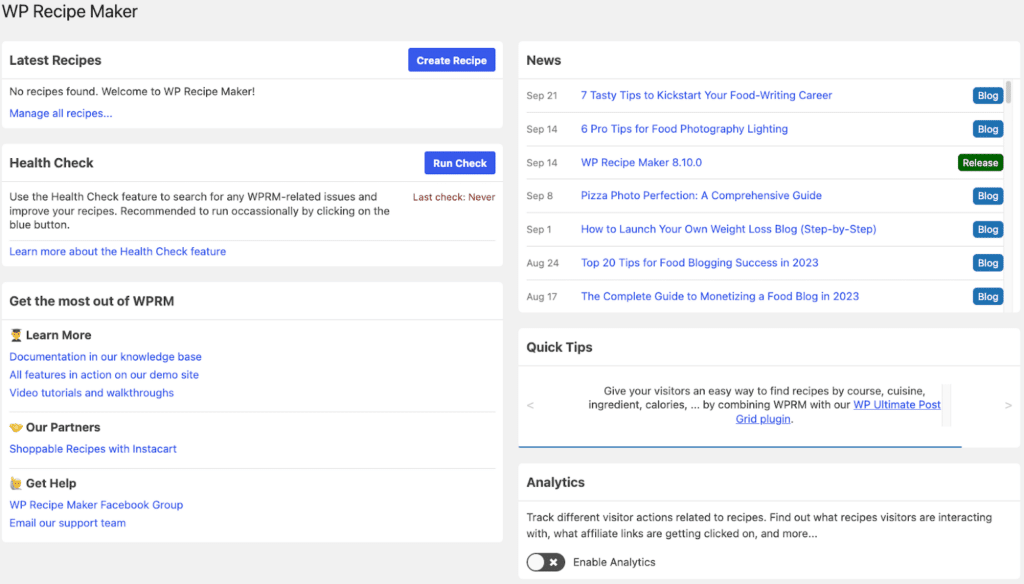
Step 3: Create your content
Having selected your niche, set-up, and optimized your fitness blog design, we are now moving into the exciting phase of creating compelling content. The aim is to develop a content marketing strategy that forms a tight-knit community and keeps them eagerly coming back for more.
Bellow are strategic tips to guide your fitness blog content creation:
- Develop a content creation process: Establishing a clearly defined content creation process not only hones the quality of your content but aids effective time management. Make use of free project management tools like Trello for idea compilation and to construct a content calendar with designated deadlines.
- Always start with content outlines: Before you commence writing, devise a blueprint for your posts, allocating each section to a unique point. This way, you can maintain focus on key themes, ensuring that each blog post addresses and resolves a reader’s concern.
- Plan your visuals: Attention-grabbing images should form an integral part of your content outline. Use original photography, download free stock photos on platforms like Unsplash, or use Canva’s brand tool kit to create consistent and unique visuals like infographics and illustrations.
- Leverage free tools to improve your posts: Tools like Grammarly are useful for correct spelling and grammar checks, while AI tools like ChatGPT are beneficial for summarizing key points and generating eye-catching blog titles.
- Run a checklist before publishing: This should include a final spell check, internal linking, and verifying SEO elements like alt text and meta descriptions.
Creating authentic and innovative content is how you can make your fitness blog stand out in the crowded digital fitness space. Here is a list of popular content ideas to spark your creativity:
- Workout routines.
- Personal training programs.
- Fitness challenges.
- Healthy meal plans.
- Nutrient-rich recipes.
- Meal preparations.
- Supplement reviews.
- Personal fitness journey.
- Techniques for individual exercises.
- Fitness equipment reviews.
- Fitness tech reviews.
- Workout gear reviews.
- Stress management techniques.
- Tips for improved sleep.
- Strategies for injury prevention and recovery.
- Fitness during pregnancy or the postpartum period.
- Fitness events.
- Guest posts.
- In-depth expert interviews.
Step 4: Promote and monetize your blog
For a successful blog, it’s essential to devise two primary strategies: one focusing on promotion to enrich your visibility and the other centered around different approaches to efficiently monetize your blog.
Promotion is vital for improving your blog’s presence and expanding your audience within the fitness blogging community. To achieve this, the majority of fitness bloggers rely on a range of popular strategies:
- Virtual and live events: Possible in-person events include group hikes, exercise classes, and informative webinars, whereas digital events can range from online cooking classes to live exercise sessions.
- Fitness challenges: Examples of these could be the 21-day yoga challenge for beginners or the September mile challenge.
- Social media: Most fitness influencers also have a very active social media following as it offers more interactive and engaging communication methods than blogging. Social media can be used to promote articles on the fitness website, products, affiliates, recipes, challenges, and events organized by the owner.
- Email marketing: Newsletters can be very effective in promoting new products, blog posts, and events that you’re organizing. However, make sure that the majority of the information is made up of useful knowledge and advice to your readers; otherwise, they won’t have an incentive to subscribe.
- Community engagement: Answer comments, emails, and DMs as much as you can, making sure that your responses are genuine and show interest in your followers’ queries. A great example of this is The Minimalist Baker – they encourage people to try out their recipes and then share the results on Instagram, tagging them in the description.

- Video content: You can post video content on your website or make a separate YouTube channel for useful tutorials, recipes, or commentary videos.
These are the general promotion strategies, but there is a whole other world when it comes to blogging monetization opportunities. Let’s take a look:
- Sponsored content: When you gain enough popularity and followers, you’ll have the opportunity to create partnerships with different brands and make sponsored posts reviewing or promoting their products. Just make sure you make it very clear that this is an ad or a sponsored article.
- Affiliate programs: With affiliate marketing, you can include links to relevant products that you use often. Every time a reader purchases that product from your link, you get a commission for it. Similar to the ads, you need to put a disclaimer that you include affiliate products in posts.
- Ad revenue: Use advertising networks like Google AdSense and Mediavine to include relevant ads on your website. With WP Recipe Maker, you can even put ads in recipe cards.
- Product sales: When integrated with WooCommerce, WordPress websites can be used to directly sell products and merchandise. In the screenshot below, you can see the Minimalist Baker’s shop, which includes their own cookbook.
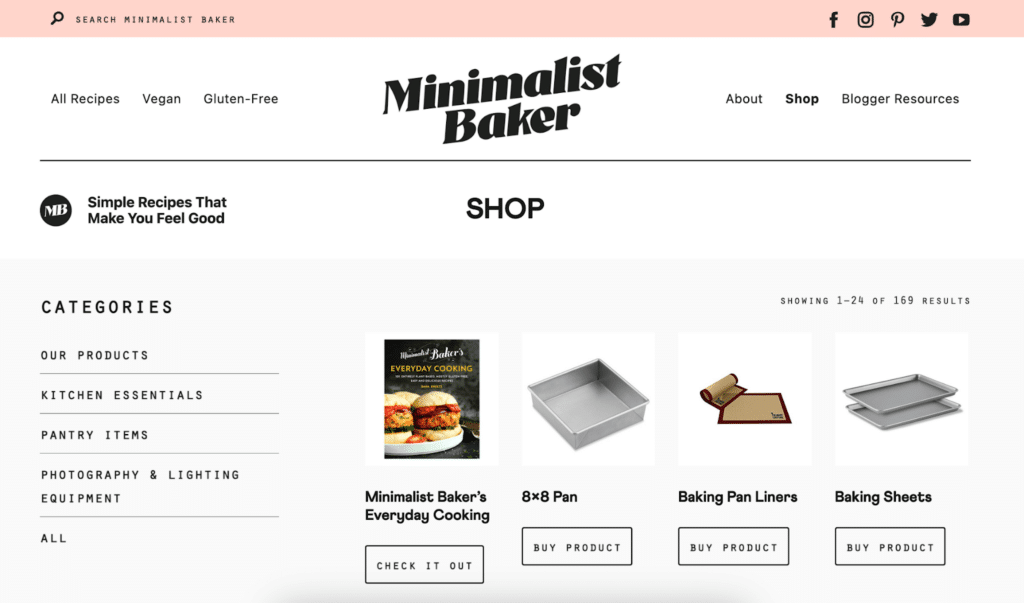
- Subscription models: You can put a paywall on your blog with exclusive content only available to website members who pay a monthly fee. This can include training programs, cookbooks, and anything else that is relevant to your niche.
- Exclusive content and donations: Similar to the subscription models above, platforms like Patreon and Ko-Fi are often used by creators to increase their monthly revenue. They usually include several tiers and content that is available only to subscribers
What do successful fitness blogs have in common?
There are as many blogs as there are stars in the sky but not all of them shine bright. Even though you should always try to be unique, there are some commonly acknowledged techniques that fitness blogs use to reach stardom.
- Credibility: You don’t need to be a certified coach or a personal trainer (it is very helpful, though) to own a fitness blog, but you do need real-life experience. For example, you’ve managed to shed a few pounds without an operation and want to share with the world your weight-loss journey and how they can get there too.
- Practical, reader-focused content: Make sure you provide followers with content that is genuinely useful to them. Be honest when you post reviews, even if they are paid. Include tutorials, training guidelines, and tasty recipes, and you’ll be sure to enjoy significant growth.
- A recipe section: An astounding 42.8% of high-traffic blogs are food blogs, so including recipes in your fitness blog is a smart way to grow your audience and potentially increase your earnings.
- Consistency: You need an exact posting schedule, and you have to make sure that you’re sticking to it. If you’re anticipating some interruption, for example, you’re going on a holiday or taking some time off, take the time to let your followers know so they don’t wait in vain.
- Authenticity: Be honest with yourself and your followers. That includes changing the direction of your blog if you no longer feel connected to the niche you started with. If you’re genuine and authentic, your readers will follow you wherever you go. Even if you get a lot of promotion opportunities, don’t flood your blog and social media solely with sponsored content and ads – people can get tired of that very quickly.
- Community engagement: The fitness industry is all about communication and improvement, so if you want to be successful, you need to regularly engage with your followers. For instance, organizing monthly Q&A sessions where people can send you questions, and you answer them in a blog post is a very good way to do this.
- Search Engine Optimization (SEO): Good SEO can make or break your website. If you’re not very good at it, there are great resources online, like our guide to SEO for food bloggers. The most important elements include keyword research, on-site optimization, and metadata.
- Data analysis: Use tools like Google Analytics and Ahrefs to track your blog’s overall performance, as well as individual recipes and blog posts. This will help you identify winning strategies and improve areas where you’re lacking.
- The ability to evolve: Last but certainly not least, you need to be able to adapt. Listen to your follower’s requests and keep up to date with trends and current events. Listen to yourself as well. If you’re not enjoying what you’re doing, what is the point in continuing? If you get to a point like this, you need to be able to change and evolve.
Fitness blogging made easy with WP Recipe Maker
Now you know the most important steps to creating a high-quality fitness blog that helps people improve through your passion for health and wellness!
We also went through some interesting fitness blog ideas, the type of content you might create, and all the different ways to make a passive income from this business.
WP Recipe Maker stands out as an ideal tool for fitness bloggers intending to include health or diet-specific recipes. The user-friendly interface and ready customization options allow you to create tailor-made, aesthetic recipe cards. Not only does WP Recipe Maker enrich visual appeal, but it also makes the task of sharing nutrition-focused recipes easy. Ready to experience the transformation this plugin can bring to your fitness blog? Don’t wait. Discover WP Recipe Maker’s pricing options today, and embark on a journey to offer your readers the engaging, informative content they seek and build a more impactful fitness blog.






